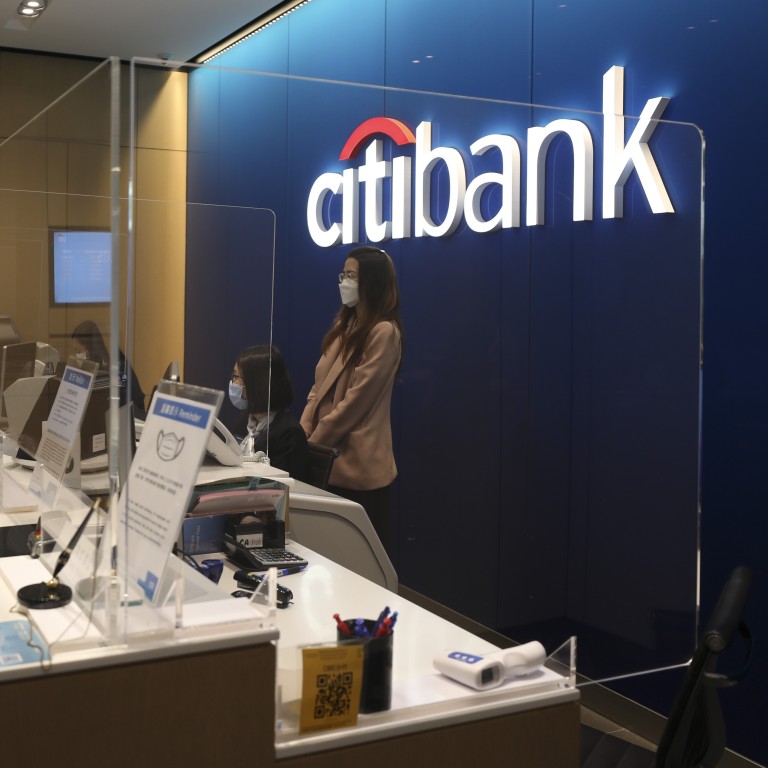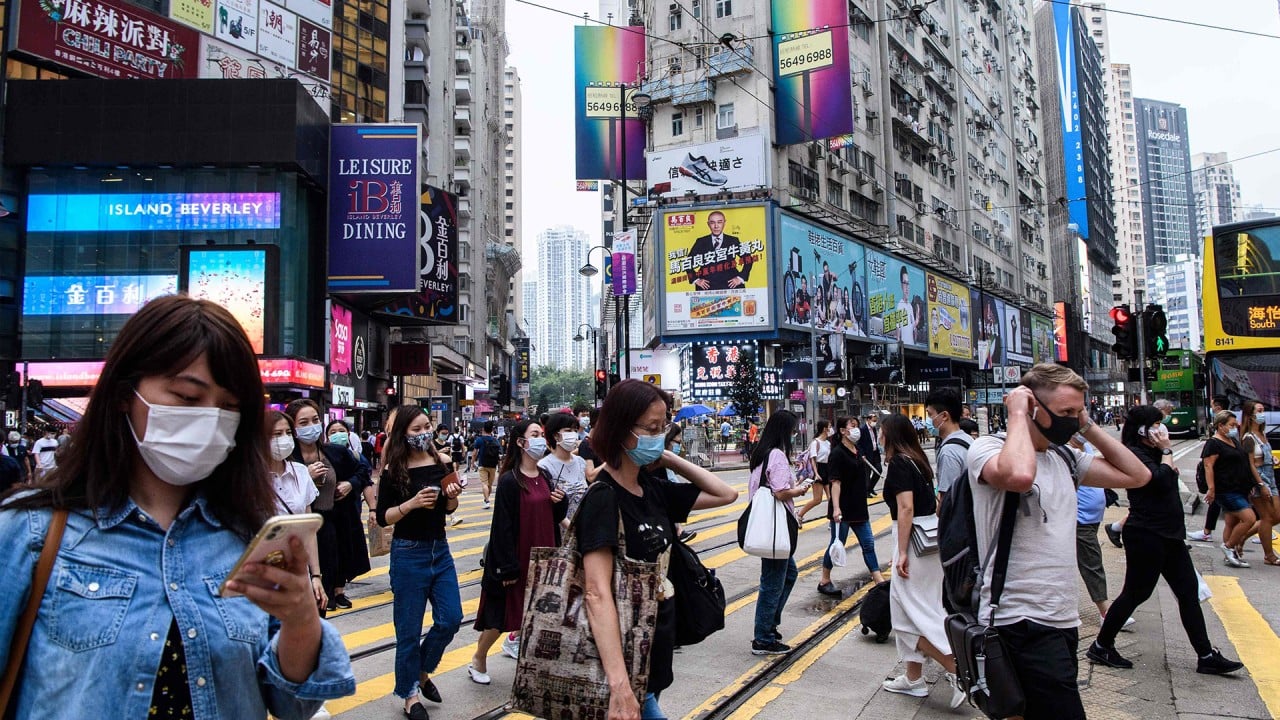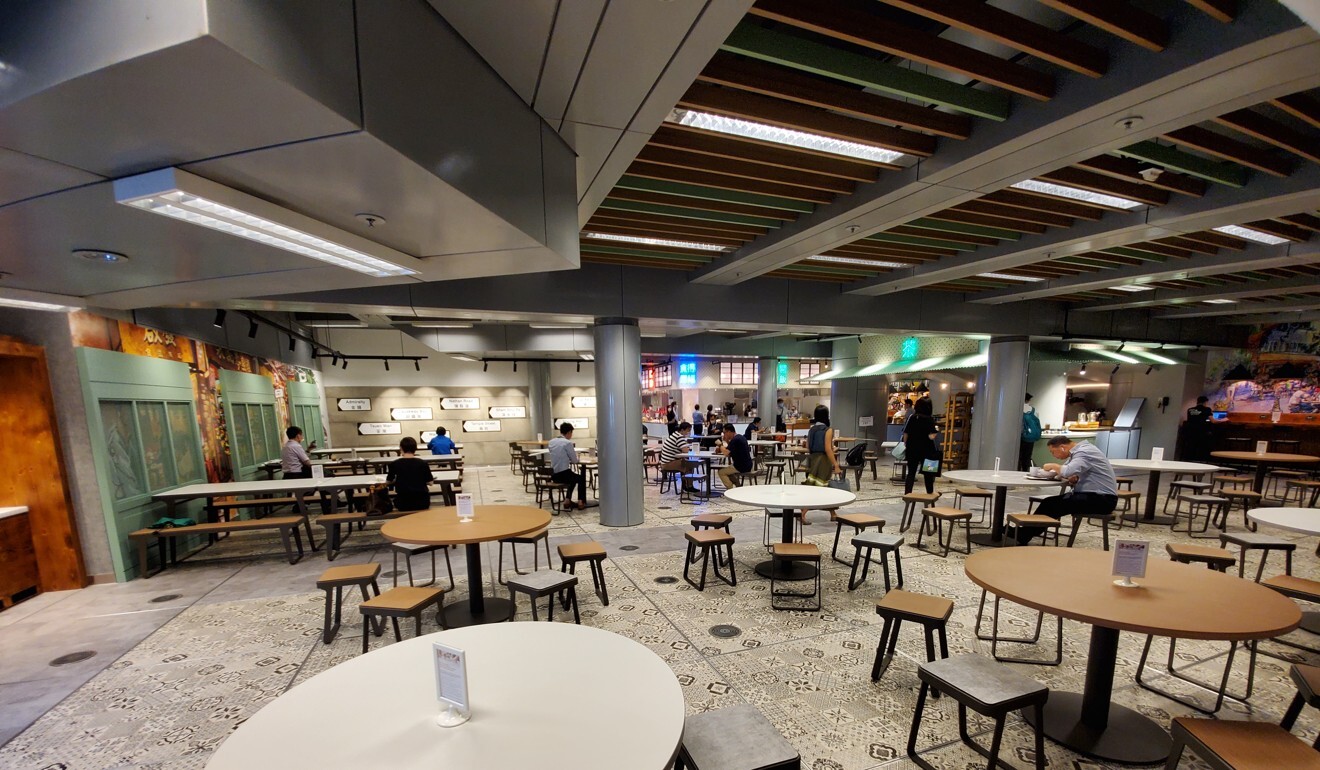
From Goldman’s ‘Team Blue’ to less crowded lifts, banks in Hong Kong are paving the way for a global return to work
- The return to work in Hong Kong could be a template for how banks bring back staff in other financial centres
- Goldman rotates teams between home and office; ICC tower, home to Credit Suisse and Deutsche Bank, tweaks lift algorithms to limit passenger load
As many of the city’s lenders prepare to bring back up to half of their staff back to the office in the coming weeks, Hong Kong is shaping up to be a test run for how global banks will fully return after months of engaging in the world’s biggest work-from-home experiment.
Bankers, fund managers and others who have spent months working remotely at their kitchen tables or from their sofas are discovering a dramatically changed environment in their office homecomings.
Staff members at Goldman Sachs are sitting at every other desk at its offices in Central and are divided into “Blue” and “White” teams that rotate between the office and home. At Citigroup, plastic dividers have been installed between seats on the bank’s trading desk and other high-density areas, such as retail branches, and a disinfecting robot patrols the lobby at its Kowloon office tower. HSBC turned its three-day China Conference that normally attracts about 1,000 people into a three-week, online-only affair.
Even the lifts have been reprogrammed at the International Commerce Centre (ICC) – home to Morgan Stanley and other global lenders – and office towers across the city to limit the number of passengers and amount of time spent crammed inside.

06:37
Coronavirus in Hong Kong: where are we now?
“Hong Kong may have seen small victories in combating Covid-19 with the recent news on the relaxation of certain social distancing measures by the government,” Angel Ng, Citi’s chief executive for Hong Kong and Macau, said in a May 18 internal memo seen by the South China Morning Post. “However, we are not out of the woods yet so we should continue to stay vigilant and not let our guard down.”
The coronavirus, which causes the disease Covid-19, has infected more than 5.3 million people worldwide and forced shutdowns of offices from New York to London to Singapore.
Banks shorten annual internship programmes, go virtual amid coronavirus
Bank employees have been declared “essential workers” in many countries, but financial institutions have embraced remote working to protect their employees and keep their markets and lending operations functioning as the pandemic threatens the global economy.
The plans under way to bring more staff back in Hong Kong – some banks had 75 per cent or more of their staff globally working from home in March and April – could be a template for workers returning to the office in other financial centres, such as New York and London.
The New York Stock Exchange, for example, is expected to partially reopen its trading floor on May 26, with only about a quarter of floor brokers present. The bourse has engaged in full electronic trading since March 23.
But other financial giants, including American Express and Visa, said last week most of their employees globally should prepare to work from home for the remainder of the year.
In Hong Kong, banks are taking it slow before returning to office in force. Citigroup increased the number of its staff in the office to 50 per cent on May 20 and Goldman is expected to do the same starting Monday, while HSBC has about 30 per cent of its Hong Kong staff in the office. Many have been rotating employees between home and the office for months and are likely to continue to do so.
Morgan Stanley, which has more than half of its employees in Hong Kong in the office, is taking a similar phased and gradual approach to bringing everyone back.
The bank’s cafeteria on the 47th floor of the ICC began serving fresh food again last month, but continues to restrict how many people can be inside at any one time. The cafeteria has just over one-third of its normal capacity and people waiting in queues are expected to stay 1.5 metres apart.
The 108-floor ICC, which is home to offices for Morgan Stanley, Deutsche Bank and Credit Suisse, has tweaked algorithms for the building’s lifts to restrict the number of passengers in each car to eight and make fewer stops. The building also has a “staff disinfection tunnel” that sanitises the uniforms and belongings of lobby workers before their shifts and added additional cleaning staff.

“I wish I had that magic answer. Unless there’s a commercially available vaccine, nobody can say we’re safely out of the woods,” Donna Chang, Deutsche Bank’s chief operating officer for Hong Kong, said. “I think this social distancing and this heightened personal hygiene expectation are here to stay. This is the new normal”
Deutsche Bank is entering phase two of its plan to return to the office on Monday, when just over half of its staff will return, Chang said. The bank has provided personal hand sanitisers and asked staff in higher density departments to keep some workstations vacant, she said.
The question of whether banks and other large companies will reduce the amount of real estate they use in office towers in central business districts remains an open one.
Barclays CEO Jes Staley told reporters last month that the bank was considering potential adjustments to its location strategy and “the notion of putting 7,000 people in a building may be a thing of the past”. He said retail branches could serve as alternative sites for investment bankers and others.
Jose Vinals, the Standard Chartered chairman, told Bloomberg last month that the bank may rethink its work-from-home practices after the health crisis subsides. About two-thirds of its staff in Hong Kong have returned to the office and all, but one of its more than 70 branches in the city have reopened.
As part of its phased return plan. Credit Suisse envisions “large numbers of employees will continue to work remotely in the short-to-medium term,” a bank spokeswoman said.
“We are working closely with local authorities to plan how we can return to the office with control measures in place that complement business continuity with health and safety,” she said.
Goldman Sachs began phasing employees in Hong Kong back over the past three weeks, but is expected to pause after it reaches a 50 per cent level.
Desks are being left empty as the bank has asked all employees to remain at least two metres apart. Goldman also has limited meeting rooms to no more than four persons and asked employees on alternative teams not to intermingle outside work.
Like many of its rivals, Citi has instituted temperature checks for all staff at its offices in Central and in Kwun Tong and is requiring the few visitors – in-person visits have been discouraged – to fill out health declaration forms. Staff are being prodded to use video or audio conferences rather than gathering for group meetings.

02:02
Coronavirus: Hong Kong to ease social-distancing rules as city sees record 8.9% economic slump
The bank is conducting hourly cleaning of all “high touch” areas, such as lift buttons and door handles, and has a robot that periodically disinfects the lobby at Citi Tower. All staff have been asked to wear masks in the office, maintain a two-metre distance from colleagues, not co-mingle with employees from other offices in the city and stagger their commutes and lunch breaks.
No more than five people can take the lift at a time at Citi Tower and dots on the floor of the car indicate where people should stand – the lifts normally have the capacity to carry up to 18 people.
The bank also has placed an antibacterial polymer coating, known as MAP-1, developed by researchers at the Hong Kong University of Science and Technology in public areas, according to Duncan Macintyre, head of Citi Realty Services, Hong Kong and Macau. The coating is refreshed every 90 days.
JPMorgan Chase had about 30 per cent of its staff back in its Chater House offices in Central beginning May 11. Some meeting rooms are limited to as few as two people and there are signs on tables indicating certain seats are off limits to encourage social distancing: an image of an office chair with a slash across it.

Employees are required to wear face masks in the office and the building’s landlord is managing lift capacity and traffic flow in the lobby.
JPMorgan plans to keep its offices at half capacity or less globally for the “foreseeable future” as it prepares to bring more of its staff back, Bloomberg News reported on May 20, citing an internal memo.
HSBC, one of three lenders authorised to issue currency in Hong Kong, has reopened all but two of its more than 100 branches and business centres in the city – the two that remain closed are at the airport – and about 30 per cent of its office staff have returned to their desks.
Clients are encouraged to wear masks when they visit HSBC branches and offices and hand sanitiser is available for customer use. The reopened staff canteen on the basement level of the bank’s main building in Central has reduced its seating by one-third.
“The current situation has nudged us to think of alternate ways of engaging clients,” Justin Chan, head of greater China for global markets at HSBC, said regarding the all-virtual China Conference this year. “While it’s too early to say if this will be the new normal, the virtual conference format has proved to be effective and successful.”

